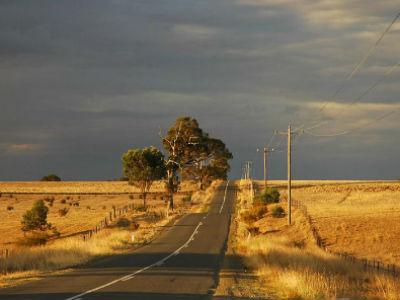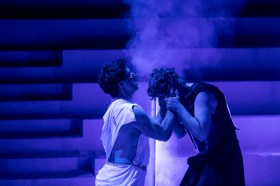‘How can art transform your town?’ is a question that’s inspiring regional communities. It began as Regional Arts Victoria’s provocation for the Small Town Transformations initiative, but as our recent road trip showed us, it’s inspired a lot more than expressions of interest for those substantial funds.
Within four days, the first of our two road trips covered eight towns and 1500km in a whirlwind series of visits to crowded gatherings. At each town, people told us just how far they’d travelled to meet us, and at each town, we were challenged with new ideas and new thinking that was grounded in community and place.
Acknowledging country at the beginning of each presentation, as well as through social media, gave us the opportunity to understand our Indigenous heritage and regional diversity that little bit more. Our journey took us across Djargurd, Wurrong, Gunditjmara, Jardwardjali, Wotjobaluk, Wergaia, Jardwa, Japagulk, Latchi Latchi, Wamba Wamba, Tati Tati, Wadi Wadi, Dja Dja Wurrung and Wutherong country, and in each place we drove too quickly past river or dry lake, mountain or open plain. Small towns greeted us with colourful welcome signs, and then – too soon! – signs hoping we’d be back one day.
Setting up for each talk told us a lot about the local community. At Ouyen’s historic Roxy Theatre, and at Charlton’s Senior Citizens Centre, new chairs presented themselves as symbols of community pride. Each of the Roxy’s bore a plaque naming its sponsor: individual members of the community whose contribution would allow one of Ouyen’s 1082 people to see shows in comfort. At Arthall Learmonth, a vibrant space for gathering and making, chairs were individually painted and beautifully unique. We could very much picture any and every one of the 301 residents at work in that creative space. And we delighted in seeing people from nearby towns meet for the first time. In Port Fairy, where my husband’s family had landed in the 1830s, a diverse community now came together. “Is that Trevor Flinn?” was the popular whisper as the artist was recognised by newcomers.
Going through our presentation gave people a chance to focus their ambitions for their towns into specific questions and ideas. The question “How can art transform your town?” is a big one – it’s open-ended, it’s provocative, and indeed it can be overwhelming. We came offering the prospect of $350,000 for artistic projects with lasting legacy, and as a new framework, the constraints it offered were generative. They prompted new ways of thinking about how a creative project addresses itself to its place, how it responds to local needs, and how it might be informed by community partnerships while sparking new ones in the process.
Frameworks for creativity open up new modes of practice because they invite close analysis as well as experimentation, bringing people and perspectives together in new ways. Suddenly a creative project can be seen as impacting on and inspiring the entire town, involving or indeed driving the entire community, creating lasting connections for further inspiration.
Community leaders come in a variety of forms. Artists who had worked closely among local collaborators for years or even decades were there at every gathering. With council or shire elections still fresh in the memory, we were heartened to see so very many new councillors keen to embrace arts and culture for their towns and their legacy. At Lake Boga near the NSW border, we meet mayors old and new, as well as several councillors full of ideas for their population of 719.
At Napoleons Primary School, one of the creative centres of a community of 1288 people, we met school principal Trevor Edwards, who not only had fostered Small Town Transformations community discussion already, but was doing so as part of a sustained commitment to the arts as the most powerful educational tool we have. Napoleons’ Eco-Cubby sat proudly in the school foyer; a puppet theatre with grassy seating graced a shady playground corner; a purpose-designed outdoor classroom offered teachers a means for stimulating fresh perspectives by performing that act themselves.
The first step in planning Small Town Transformations is for a town to identify a need for transformation. Something we were struck by again and again was people’s need to be heard on those very needs. As an arts organisation, we could only respond to creative and cultural needs, and along our journey we overcame our own urban remoteness by listening carefully. Deepening our relationships with Regional Development Victoria and the Municipal Association of Victoria will allow a strong arts voice to be heard in policy, planning and development matters, and this is a renewed priority for us. After all, only art can bring people together in ways that plan generously and constructively for a future everyone’s passionately excited by.
Our journey was inspiring and engaging, emotional and exhausting. For Liz Zito, Manager of our Regional Cultural Partnerships, it was an important opportunity to catch up with members and partners, as well as former collaborators and past home towns across her decades-long regional arts work. For Joanna Gould, coordinating Small Town Transformations as part of her role of working closely with me, it was a first opportunity to meet the many people on the other end of the email or phone call, and see many new places for the first time. (Track back on our three Twitter feeds to experience each of our perspectives on the journey.)
Towards the end, all three of us had a tear in our eye as a lady in Learmonth explained what this opportunity had already meant for her nearby small town. “We know that only five projects are going to be successful,” she said, “but already we’ve come together in ways I haven’t seen for a long time. We’re getting past the distrust, we’re actually talking to one another and we’re going to make this happen.”
I answered her comment with a hug. For all three of us – for everyone at Regional Arts Victoria – this was exactly what it was all about. As we left that hall with our gear all packed up and the route to the next town forming in our heads, we saw a dozen or more people gathered around a table having that very discussion. Creative transformation can only begin with real, open conversation, building trust and making commitments. And then, who knows: a bunch of other ideas could emerge – some bigger than Small Town Transformations, some much smaller – so at each town, we offered people other support and funding opportunities for those ideas. Find them on the website at http://smalltowns.rav.net.au, including Liz’s tips for getting started.
When we found ourselves Melbourne-bound once again, we felt just that much more inspired that the next time we’d gather in those same places, we’d be challenged to take those new connections to a whole new level.
Next month, we do it all again: Yinnar, Bairnsdale, Yarragon, Wonthaggi, Echuca, Dookie, Wangaratta and Yea, from February 11 to 14. At these info sessions we’ll be focusing on the application forms, supporting the preparation of EOIs in time for the following week’s deadline. Find our schedule on the website – as well as the discussion page, being enriched right now by the people we met at Camperdown, Port Fairy, Horsham, Ouyen, Lake Boga, Charlton, Learmonth and Napoleons.
Expressions of interest for Small Town Transformations close at noon on Thursday, 21 February 2013.






